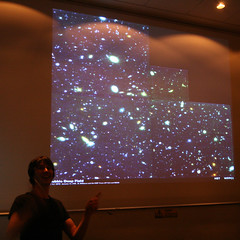 Image via WikipediaThe findings of the space telescope Hubble only confirms my theory which goes against the belief of most cosmologist who think time travel is possible.
Image via WikipediaThe findings of the space telescope Hubble only confirms my theory which goes against the belief of most cosmologist who think time travel is possible.
My theory is that,"you cannot go back through time or move forward through time."
Scientist and cosmologists assume that the light from new planets and galaxies Hubble is discovering is only now appearing in our solar system, and if we could reach them we could travel back in time, closer to when the "Big Bang" occurred.
Hubble is only 370 miles or 600Km above the earth's surface, so if the light from these sources was reaching Hubble then the light source would be seen by the naked eye on earth seconds after it reached Hubble, considering the speed light travels.
No matter how fast light travels we on earth will never see these lights with our naked eyes as it is Hubble that is reaching out into space to these light sources.
You have to consider that light comes from a heat source and light only travels as far as the intensity of that heat source allows.
The more intense the farther the travel and the less intense the less travel, its common sense.
Light does not travel on and on forever!
If it ever becomes possible for us to reach the limits of space we would not be traveling through time, we would only be reaching the extremities during universal time. Not going back and not going forward in time.
If, as most of us believe that the universe began with "The Big Bang," and we could reach the planets that have formed nearer to where the explosion took place, we would not be going back nearer to the time of the Big bang, we would only be going to these planets or galaxies and be able to see them as they are, and to observe how they have developed since the explosion took place.
They probably have had more time to develop than the remnants that traveled farther and any life on them could be far more advance than we are.
If you freeze frame any explosion the results of each frame will show what is happening at exactly the same time to the fragments nearest to the blast and to the fragments farthest away.
Looking at the fragments nearest the blast is not taking you nearer to the time the explosion was set off.
The result is the same with the universe only it is on a much larger scale than we can envisage, and the lights deep in space that Hubble is discovering will come no nearer to us but develop in their own part of the universe.
Scientists and cosmologists are still assuming that the light from the farthest galaxy has just reached us when it is the telescopes mankind has developed that are reaching out to them.
Their dream of being able to time travel is blinding them from reality.
Another thing to think about is, what if we could place Hubble 370 miles above one of these distant planets that are part of a galaxy 13 billion light years from us to reach out 13 billion light years beyond that?
What would it discover then?
More planets and galaxies, that is the answer.
From our little speck of dust that we call earth, we will never see the vastness of the universe and assumptions of how it came to be will always be made until, maybe someday, people from a planet that is far in advance of our own might come and explain the truth of it all to us.
Some people on earth think they have already been here, some think they still are, but whoever, if any are right, they will not want to expose themselves to violent peoples such as we have on earth.
Maybe when we can learn to live in peace with our own kind and show we are no threat to them, then the mysteries of the universe will be unfolded to us.








